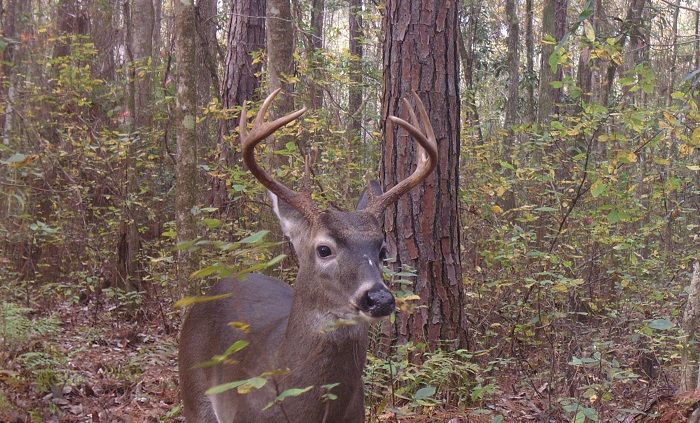
by Mark Mauldin | Nov 8, 2019

There are new regulations this season involving mandatory reporting of all deer harvested in Florida.
Photo Credit: Mark Mauldin
Deer hunting season here in Northwest Florida officially started this past Saturday (10/26) with the opening of archery and crossbow season; muzzleloading and general gun season will both open later this month. If you are fortunate enough to find success hunting in the woods, it is important that you remember substantial changes have gone into effect regarding the mandatory reporting of harvested deer. The following is a only a summary of some of the new regulations – complete official hunting regulations are available from the Florida Fish and Wildlife Conservation Commission.
The primary new regulation, put as simply as possible (again, this is only a summary):
All hunters must log their harvested deer prior to moving it from the point of harvest and report their harvested deer within 24 hours.
A hunter may log a harvested deer on a paper 2019-2020 Deer Harvest Log or via the FWC Deer Harvest Reporting App. The app allows a hunter to log and report a harvested deer, completing the process. If a hunter logs a deer on the paper form, they must also report the deer by calling 844-392-DEER (3337) between 8 a.m. – 8 p.m. ET or reporting online at MyFWC.com/HarvestReport. When successfully completed, either of these options, calling or going online, will result in a confirmation number. The confirmation number must be recorded on the Deer Harvest Log for the process to be complete. Note: using the app also generates a confirmation number that is automatically saved in the “sent” folder within the app. Follow the link for step-by-step instructions for using the FWC Deer Harvest Reporting App.
-
All harvested deer must be logged (on paper form or with the app) prior to being moved from where they were originally found.
-
All harvested deer must be reported (phone, online, or app) and confirmation number recorded on the paper log (or automatically on the app) within 24 hours of harvest**.
**Hunters must report harvested deer: 1) within 24 hours of harvest, or 2) prior to final processing of the deer, or 3) prior to the deer or any parts of the deer being transferred to a meat processor or taxidermist, or 4) prior to the deer leaving the state, whichever occurs first.
Hunters should be prepared to log and report harvested deer before they go hunting. They should have a copy of the 2019-2020 Deer Harvest Log with them, or have the FWC Deer Harvest Reporting App installed on their mobile device. In order to successfully log and report a harvested deer the hunter will also need the following information:
- Name (first and last name of the person who harvested the deer)
- Date of birth
- FWC Customer ID number (CID)
- Date of harvest
- Time of harvest
- Public or private land
- County
- Deer management unit
- Wildlife management area (if applicable)
- Method of harvest
- Antlered or antlerless deer
- Number of antler points (if antlered deer was indicated)
- Antlerless male or female (if antlerless deer was indicated)
- For deer taken on private lands, whether a deer program permit was used (Antlerless Deer Program permit or Private Lands Deer Management Program permit)
- 6-digit Tag number (if a deer program permit was used)
Another change for this hunting season is the establishment of the annual statewide bag limit of 5 deer per person of which no more than 2 deer can be antlerless.

FWC Deer Harvest Reporting APP
https://myfwc.com/hunting/deer/harvest-report/?redirect=harvestreport

FWC Deer Harvest Reporting Log
https://myfwc.com/media/21998/deer-harvest-log.pdf
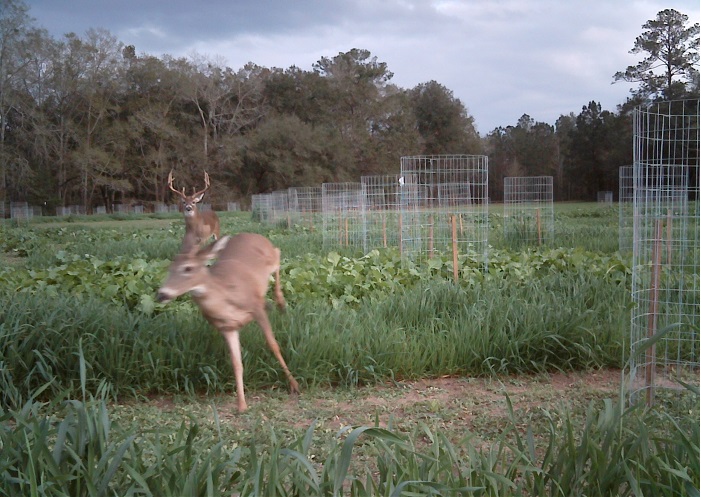
by Mark Mauldin | Sep 2, 2018

A buck chases a doe through plots of wildlife forages being evaluated at the University of Florida’s North Florida Research and Education Center. Photo Courtesy of Holly Ober
I know it feels too hot outside to talk about hunting season or cool-season food plots, but planting time will be here before you know it and now’s the time to start preparing. The recommended planting date for practically all cool-season forage crops in Northwest Florida is October 1 – November 15. Assuming adequate soil moisture, planting during the first half of the range is preferred. Between now and planting time there are several factors that need to be considered and addressed.
Invasive and/or Perennial Weed Control – Deer and other wildlife species utilize many soft/annual “weeds” as forage so controlling them is usually not a major concern. But from time to time unwanted perennials (grasses and woody shrubs) need to be controlled. An unfortunate and all too common example of and unwanted perennial is cogongrass – a highly invasive grass that should always be controlled if found. Effective control of perennial weeds, like cogongrass generally involves the use of herbicides. Late summer/early fall is a very effective time to treat unwanted perennials. Fortunately, this coincides well with the transition between warm-season and cool-season forages. If you have unwanted, perennial weeds in your food plots get them identified now and controlled before you plant your cool-season forages.
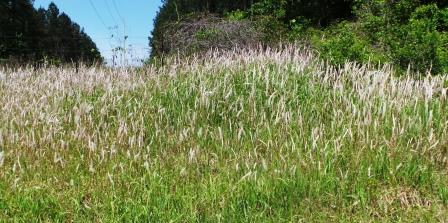
Cogongrass shown here with seedheads – more typically seen in the spring. If you suspect you have cogongrass in or around your food plots please consult your UF/IFAS Extension Agent how control options.
Photo credit: Mark Mauldin
Soil Fertility Management – In my experience, the most common cause for poor plant performance in food plots is inadequate soil fertility. Before planting time collect and submit soil samples from each of your food plots. Laboratory analysis of the samples will let you know the fertilizer and lime requirements of the upcoming cool-season crop. It is very important to have the analysis performed prior to planting so performance hindering issues can be prevented. Otherwise, during the growing season, by the time you realize something is wrong, it will likely be too late to effectively address the problem. This is particularly true if the issue is related to soil pH. To affect soil pH in a timely manner lime needs to be incorporated into the soil. Incorporation is impossible after the new crop has been planted. Soil analysis performed at the University of Florida’s Extension Soil Testing Lab cost $7 per sample. Your county’s UF/IFAS Extension Agent can assist you with the collection and submission process as well as help you interpret the results.
Variety Selection & Seed Sourcing – Sometimes it takes some time to find the best products/varieties. Just because forage seeds are sold locally doesn’t mean that the crop or specific variety is well suited to this area. The high temperatures and disease pressure associated with Florida, even in the “cool-season” mean that many products that do very well in other parts of the country may struggle here. Below are some specific forages that are favored by wildlife (specifically white-tailed deer) and generally well adapted to Florida. You may discover that these varieties are not sitting on the shelf at the local feed & seed. Often local suppliers can get specific varieties, but they must be special ordered, which adds time to the process. Hence the need to start planning and sourcing seed early.
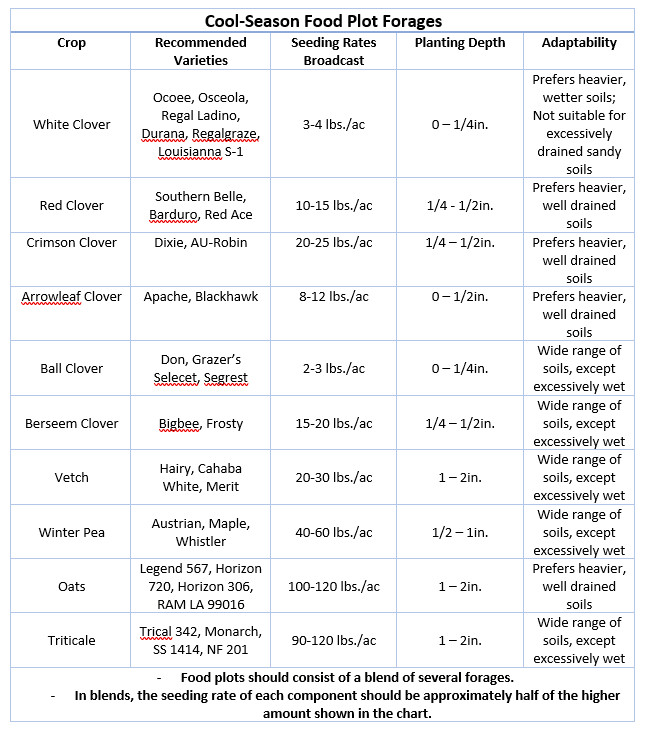
If you are debating trying food plots on your property for the first time, please carefully consider the following. Food plots are not easy – Making productive food plots that provide a measurable, positive impact to the wildlife on your property takes considerable time, effort, and money. Considering this, food plots really only make sense when viewed as habitat improvements that provide long term benefits to multiple wildlife species. If you are looking for nothing more than a deer attractant during hunting season food plots are not a very practical option. For more information on getting started with food plots contact your county’s UF/IFAS Extension Office and check out the reference below.
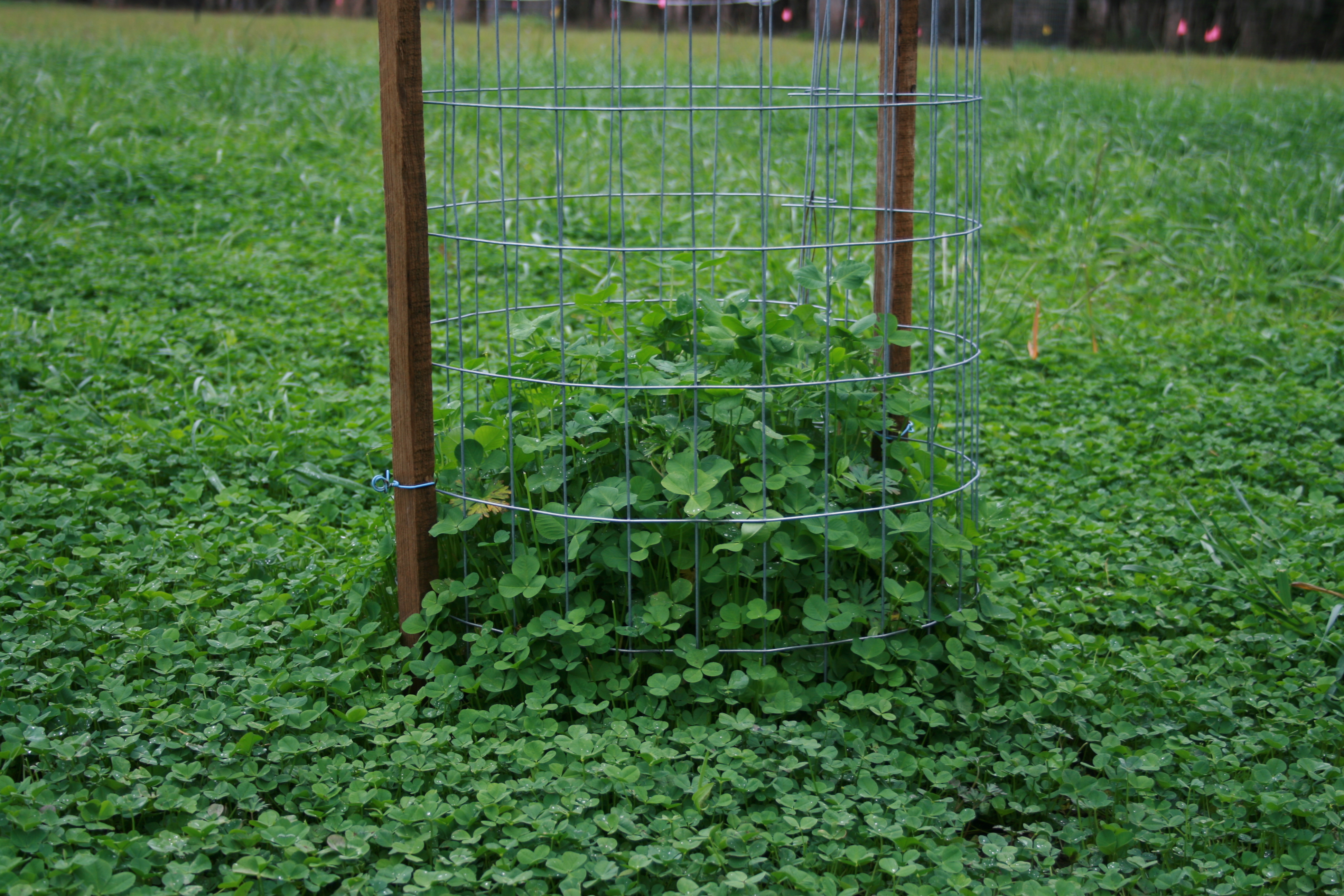
by Jennifer Bearden | Aug 15, 2014
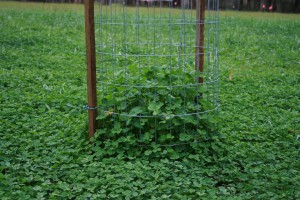
Exclusion cages help us determine how much forage is being produced and consumed. (photo by Jennifer Bearden)
It’s time to start planning your cool season wildlife food plots. Cool season food plots do a great job attracting deer and other wildlife to your property as well as providing a little nutrition. The first step is to choose an appropriate location. Remember wildlife like to stay close to cover but plants also need sunlight. Cool season food plots are generally smaller than warm season food plots (about an acre or so is sufficient). Once you find a suitable location, have your soil tested. Soil test results give you important information like pH, phosphorus levels and potassium levels. In August, perform your soil test so you have more time to adjust your pH. Adjust pH if necessary with lime applications. Cool season forage options include:
- Legumes – arrowleaf clover, crimson clover, ball clover, red clover, white clover, vetch and winter peas to name a few.
- Grasses – ryegrass, oats, wheat, rye, and triticale (a man made cross of wheat and rye).
- Brassicas like kale, turnips and tillage radish
- Forage Chicory
Legumes need to be inoculated with a rhizobium bacteria prior to planting. This will allow the plant to manufacture nitrogen and eliminate the need for extra nitrogen application. The pH range for most of these plants will between 5.5-7.0 but some clovers need a higher pH. I would recommend planting a mixture of these forages. One mixture that had a lot of success in our research plots in Quincy included arrowleaf clover, red clover, crimson clover, white clover, buck forage oats and tillage radish. The target pH for that mixture would be 6.0.
Cool Season Food Plot publication: A Walk on the Wild Side: 2013 Cool Season Forage Recommendations for Wildlife Food Plots in North Florida
by | Jan 3, 2014
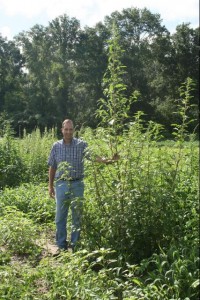
Palmer amaranth can reach heights up 10 feet and signal real trouble for hunters, farmers, and land managers. Loaded with numerous small seeds, mature plants and “offspring” are difficult to control. Photo Courtesy of University of Florida / IFAS
Deer feeders are common in North Florida, and “deer corn” is sold in multiple markets. Cross-roads convenience stores sell it in plain brown bags and big box stores in town sell it in camouflage bags with three color pictures of giant bucks on the front. With the high price of corn in 2012, many hunters saved a few dollars buying “combine run” corn from local farmers or corn screenings from grain elevators. The corn’s no different, however, either product can contain weed seed, especially Palmer amaranth. These weeds can mean big trouble for farmers and hunters.
Palmer amaranth is a species of pig weed, but it’s not your granddaddy’s “careless weed”. It’s taller than either red root pigweed or spiny pigweed, and is becoming resistant to several herbicides, most notably glyphosate (“Roundup”). Amaranth seed are small and plentiful (1 to 1.5 millimeters in diameter) and easily can fit in the nooks and crannies of grain harvesting and handling equipment.
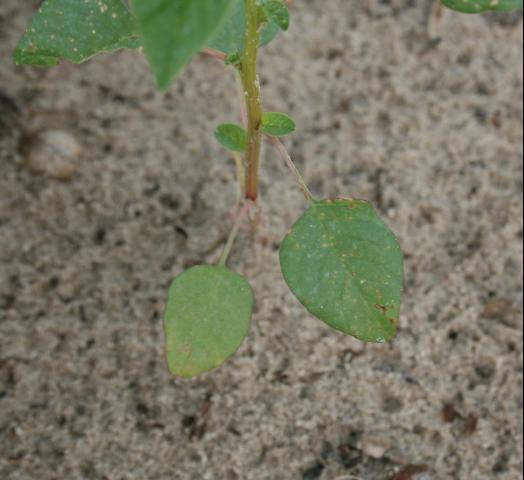
Palmer amaranth first true leaves have small notches on the end and can serve as an identifying characteristic. Photo Courtesy of University of Florida / IFAS.
Once Palmer amaranth seed make it into a deer feeder, there’s a huge opportunity for seedlings to take root in places under the radar of typical scouting and control measures. If these seedlings are herbicide resistant, you’ve done far more harm to the landowner than any savings on corn cost can offset. Conservative estimates indicate herbicide costs have at least doubled due to herbicide resistant weeds. Do your local farmer a real favor; scout and control weeds coming from your deer feeder.
Further information on identifying and controlling Palmer amaranth is available from your county Extension agent or at http://edis.ifas.ufl.edu/ag346
Feeding corn to deer and turkey is permitted by the Florida Fish and Wildlife Conservation Commission as long as the following restrictions are met. “Resident game and wild hogs may be hunted in proximity of year-round game-feeding stations on private lands, provided the feeding station has been maintained with feed for at least six months prior to taking resident game,” and “Wild turkey may not be taken if the hunter is less than 100 yards from a game feeding station when feed is present.” See General Information regarding Feeding Game at http://myfwc.com/hunting/regulations/general-information











